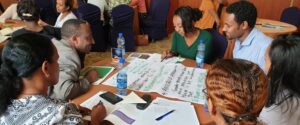
How do you do capacity development well?
Lately there have been several opportunities for reflection on capacity development in our sector – what good capacity development looks like and what might be less good. The UK’s Independent Commission for Aid (ICAI)’s report on some of the UK’s development research funding schemes highlighted concerns related to both effectiveness and equity, and these issues were considered in two conferences that I participated in over the past few weeks – a panel discussion we-convened at the Development Studies Association conference on rethinking collaboration (under the Rethinking Research Collaborative), and a conference in Oxford on ethics.
With these discussions fresh in my mind, it seemed a good opportunity to offer six suggestions for how we can approach capacity development more equitably, and more effectively.
1. Capacity always already exists – we need to start there, not with what we bring.
This first point is all too often overlooked. There is always existing capacity in a system or institution, and if we want to contribute meaningfully we should be thinking about how we augment and add value to what is already there.
We should always be designing work together. Of course, it takes time – but there’s little point embarking on a process of capacity development if it doesn’t involve partners, and the results will always be better where there is shared ownership, and mutual investment in the success of a project.
2. Understand the context – the limits of technical skills development
We tend to describe capacity and its development in technical terms – skills to be built, capacities needed, knowledge gaps, resource constraints etc. But developing capacity is about a process of change. That means it’s political – it’s about the ways things are done, the incentives and interests that underpin that, those who hold power and those who don’t.
3. Capacity development can’t just be a ‘bolt on’ to a research project
A lot of efforts achieve little in the way of lasting change or capacity, because they are poorly designed, insufficiently resourced, they don’t make use of the right expertise, and there’s no clear attention to the pathway for learning and change. Instead the focus is often on one-off training workshops. To do capacity development well it can’t just be an afterthought, a bolt on to a research project to satisfy the conditions of a funding call.
Doing capacity development well
4. Don’t just focus on individuals — think about the levels of change
Many initiatives focus entirely on individuals – for example, training a group of researchers in scientific methods or writing. Done well, this can certainly be valuable and can really help individual researchers and scholars. But if you train a group of researchers, what happens next year? How do the next cohort of PhDs or early-career staff get trained? How will a person with skills thrive in a department where they can’t use them?
We need to think about organizational and system levels of capacity.
At the organizational level, we should think about developing in-house programmes that continue, every year – so working with universities and research institutes to develop these, and to develop their own teams of facilitators.
Working at the systems level is probably hardest of all. But it may be possible to have an impact at a system level by working with multiple institutions to develop a wider programme of support, or by convening different types of organizations to identify strategies for change. And in all cases, we should be cognisant of the system level incentives and policies which frame, support, or in some cases create obstacles – and design with those in mind.
5. Design for learning. What’s the purpose? What do you want to achieve?
We should be thinking hard about what we are trying to achieve, and what support our learners need – because if we’re strengthening capacity, we’re implicitly engaged in a learning process. Do we want to engage a group of learners around an issue, which may be new to them? Do we want to develop foundational knowledge, or do we want to strengthen skills? Do we want to give space to master competencies – ie to put skills into practice?
If we can identify what we’re trying to achieve more clearly, then we can think about the best way to support that learning and achieve those goals.
6. Get beyond the one-off training workshop
Whatever we’re trying to achieve, we need to avoid the tendency to think automatically about a face to face training workshop. Peer learning networks or discussion spaces, or mentoring over a longer period, may be more appropriate. Or it may be about a facilitated problem-solving or design session. It should probably be a combination of several modes of support.
Blended learning – combining a mix of face-to-face sessions with online sessions, or bringing digital tools into a physical workshop – can transform what is possible. As connectivity improves and more people have access to digital technologies, there is huge potential.
Online learning can enable you to go where a workshop can’t. It can also help you to get to scale – to reach more people, including in places where it would be much harder to bring people together for a workshop. We are experimenting with a series of journal clubs – online discussions using a mix of WhatsApp, and Zoom and other tools to bring people together for shorter sessions to discuss a range of topics, facilitated by partners from our AuthorAID network. It also means you can also deliver learning is at the point of need. There’s no need for a week away, when you can fit it in around work and family life, and you can study when it suits you and apply what you learn as you go.
If a face-to-face workshop is needed, then digital platforms can help to prepare participants and support them afterwards. What starting knowledge do they need to make it valuable, useful? What will happen after the workshop? How do we ensure continuity of learning, and provide on-going support to ensure that skills and knowledge can be mastered, put into practice?
Doing capacity development with limited resources?
Good capacity development can’t be done on the cheap. It needs expertise, and that means it requires time. One the other hand, bad capacity development is expensive – scarce resources are wasted, including time of the participants, and at its worst it can undermine capacity and confidence and have a limited lasting impact.
Those operating on smaller budgets can avoid reinventing the wheel by working with those who already do it, leveraging and building on existing resources and expertise.
So to re-cap:
- Capacity already exists –start there, not with what you bring
- Understand the context – the limits of technical skills development
- It can’t just be a ‘bolt on’ to a research project
- Don’t just focus on individuals – think about the levels of change
- Design for learning. What do you want to achieve?
- Get beyond the training workshop. Digitally enhanced and blended learning. Peer learning, coaching, mentoring.

 Previous Post
Previous Post Next Post
Next Post



Some insights indeed.